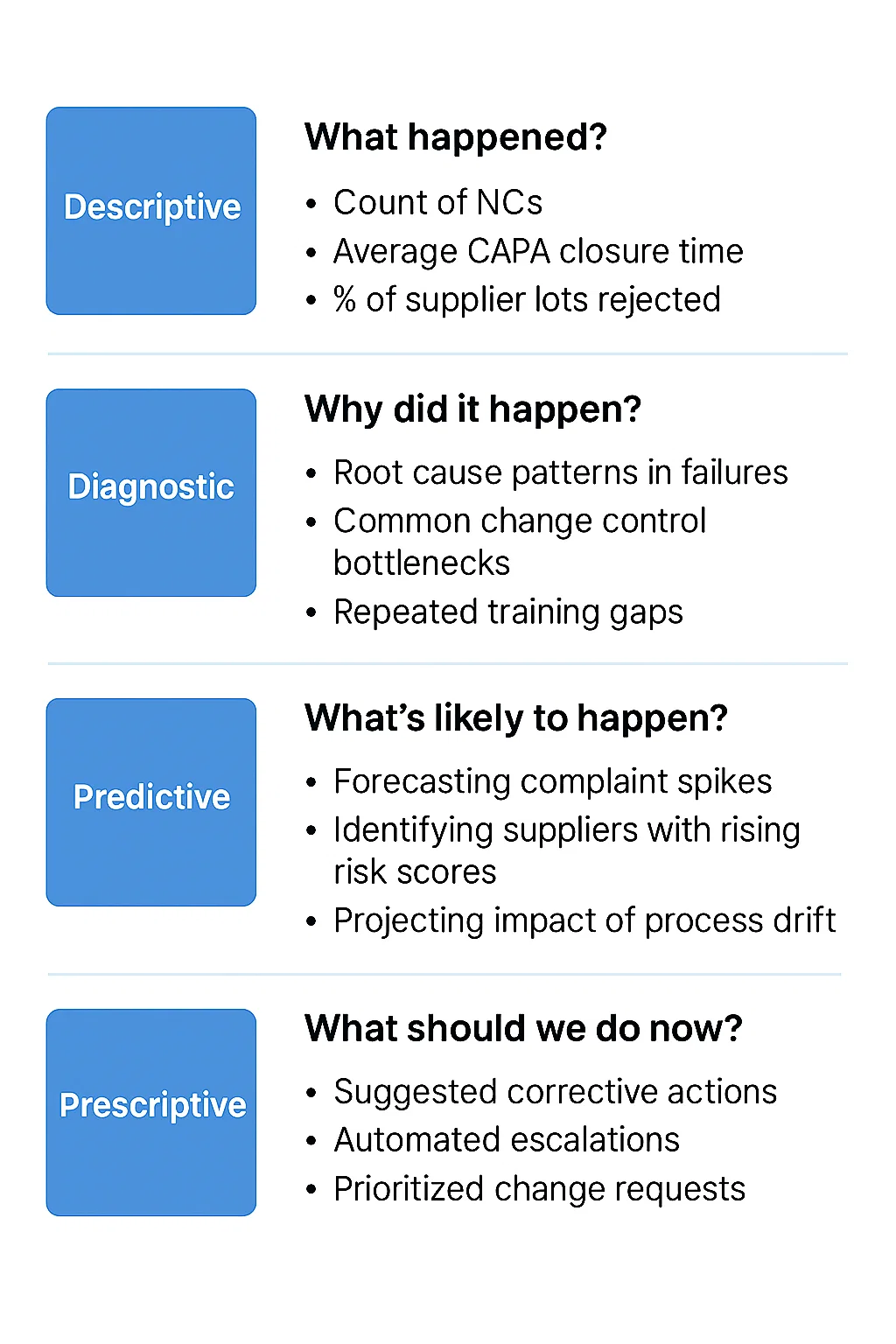Quality can’t be a checkbox anymore. In an era of compressed launch timelines and sprawling, fragile supply chains, you don’t have the luxury of waiting for the audit to reveal what went wrong—you need to see it as it’s starting to go wrong. Regulators and customers now expect real-time traceability, not annual binders. The challenge? Most quality data is already there—buried in NCs, CAPAs, change records, supplier emails, complaint logs—but it’s scattered across spreadsheets and siloed systems.
At the same time, AI and modern analytics promise to surface patterns, predict failures, and recommend actions. But AI is only as good as the context and completeness of the data it sees. The companies pulling ahead are the ones connecting people, processes, and data so insights don’t die in another inbox thread.
This blog explores what “data & analytics in quality” truly means—and how Unifize helps you harness that data to drive continuous improvement, not just compliance.
What “Data & Analytics” Really Mean in Quality — and Why It’s Hard
Quality teams sit on a goldmine of information—design history files, nonconformance and CAPA records, engineering change orders, training and competency logs, supplier performance data, and customer feedback. The problem isn’t a lack of data; it’s stitching all of those streams into a coherent story you can act on. That’s where analytics comes in, and it’s more than “pretty charts.”
Think of analytics as four modes you switch between, depending on the question you’re asking—not a staircase you climb once:

These modes aren’t hierarchical; they’re a cycle of questioning that feeds continuous improvement. Without connected context—who approved what, in response to which event—analytics devolves to disconnected charts. With context, you unlock faster, smarter decisions that actually change outcomes.
Ultimately, “data & analytics” in quality means shrinking the gap between signal → understanding → action. It’s not about having dashboards for every metric—it’s about embedding insight where work happens, so teams can ask better questions and act before problems snowball.
So why isn’t everyone doing this already? Because friction lives everywhere:
- Fragmented Narratives: The data and the discussion about it live in different places. Metrics lose meaning when the “why” is buried in email threads.
- Time-Lagged Truths: By the time spreadsheets are reconciled, the insight is stale and the window to act has closed.
- Metric Mistrust: Multiple sources lead to dueling dashboards, endless alignment meetings, and skepticism about “whose number is real.”
- Governance Gaps: No clear owner for data definitions, cleanup, or change logs; bad data persists and improvements stall.
- Audit Paralysis: Fear of breaking validated processes stifles experimentation with new fields, views, or analytics workflows.
- Low Data Fluency: Teams record events but struggle to interpret trends or ask deeper analytical questions.
A Maturity Model for Data-Driven Quality
Moving from spreadsheets to AI-assisted quality isn’t a single leap—it’s four recognizable plateaus. Spot where you’re standing, then use the quick self-check to see how consistently you cycle from insight to action.
How Unifize Enables Data-Driven Quality
Unifize was built around a simple idea: if people, processes, and data sit in one living workspace, quality stops being a compliance chore and becomes a source of strategic speed and savings. Here’s how the platform turns that promise into a daily reality.
1. Unified context—every record, file, and conversation in one place
Traditional eQMS tools store the form while the real discussion happens in email or Slack. Unifize fuses them: each CAPA, change request, or audit finding is an “object” that carries its own chat thread, approvals, attachments, and full decision history. Nothing is lost to side channels, so analytics can mine both the numbers and the narrative in a single query.
2. Real-time collaboration that eliminates silos
Chat is built into every workflow step. Engineers, suppliers, and auditors can @-mention one another, drop a spec PDF, or sign off—without exporting or emailing anything. The result is hours saved per issue and faster cross-functional alignment, because everyone sees the same live context instead of version-locked files.
3. Embedded analytics you don’t have to beg IT for
KPIs like CAPA cycle time, NC recurrence, and supplier scorecards are available out of the box; power users can slice data further with self-serve filters. Because the dashboards sit on the same data graph that runs daily work, they refresh instantly—no nightly ETL, no PowerPoint exports. Teams drill from a red metric straight into the underlying record, chat thread, and attachments, turning “why is this high?” into an answer in a few clicks.
4. Open integrations & low-code APIs
Whether quality data needs to flow to an ERP for cost rolls, an MES for shop-floor traceability, or a BI lake for corporate analytics, Unifize exposes REST and webhook endpoints and supports iPaaS connectors. That keeps it a “single source of truth” without becoming a walled garden.
5. Compliance-by-design, not bolt-on
Every action—field change, chat message, e-signature—is time-stamped and locked into a Part 11–ready audit trail. Forms map to ISO 13485 and FDA 820 requirements out of the box, so new processes inherit validation logic automatically. Auditors see one contiguous chronology instead of chasing attachments across drives.
6. AI & automation that surfaces the next best move
Context-aware AI models tag recurring failure modes, flag anomalies in supplier trends, and suggest next-step tasks before humans even open the record. Think of it as a digital quality engineer who never sleeps, constantly learning from the conversation data your team is already creating.
Why it matters
This fusion of context, collaboration, analytics, openness, compliance, and AI is why users like Biovation Labs could consolidate 16 SKUs to two and save $60 000 in a single negotiation. When the platform itself reflects how quality work actually happens, insight flows naturally—and the distance from signal to action shrinks from weeks to minutes.
Questions to Ask Any QMS Vendor About Analytics
Turning Data & Analytics into Your Competitive Edge
When every design file, supplier spec, and shop-floor event flows into a single analytics engine, decisions accelerate from days to minutes. Patterns emerge sooner, corrective action becomes preventive action, and audits shift from stressful to straightforward. Unifize unifies those data streams and wraps them in real-time insight, so your teams act on trends instead of chasing them—unlocking faster launches, lower costs, and a culture that treats data as the fuel for continuous improvement, not just record-keeping.





